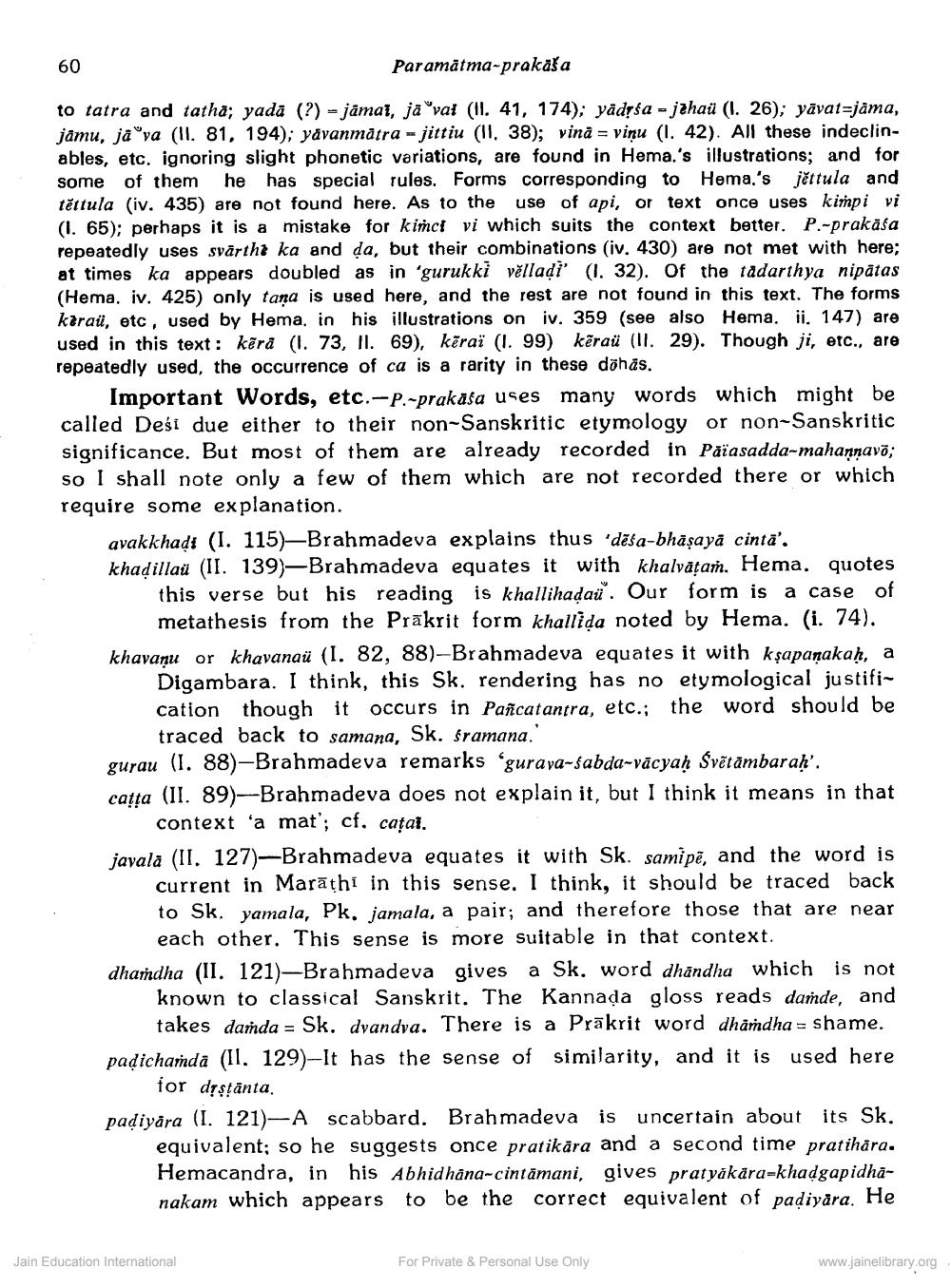________________
60
Paramātma-prakaša
to tatra and tatha; yada (?) - jämai, jā"val (II. 41, 174); yàdīša - jahai (I. 26); yāvat=jāma, jāmu, jāova (Il. 81, 194); yavanmátra - jittiu (II, 38); vină = viņu (1. 42). All these indeclinables, etc. ignoring slight phonetic variations, are found in Hema.'s illustrations; and for some of them he has special rules. Forms corresponding to Hema.'s jéttula and tęttula (iv. 435) are not found here. As to the use of api, or text once uses kimpi vi (I. 65); perhaps it is a mistake for kimct vi which suits the context better. P.-prakasa repeatedly uses svärtha ka and da, but their combinations (iv. 430) are not met with here; at times ka appears doubled as in 'gurukki vělladi' (I. 32). Of the tadarthya nipätas (Hema. iv. 425) only tana is used here, and the rest are not found in this text. The forms kerai, etc, used by Hema. in his illustrations on iv. 359 (see also Hema. ii. 147) are used in this text: kērå (. 73, II. 69), kēraï (I. 99) kēraü (II. 29). Though ji, etc., are repeatedly used, the occurrence of ca is a rarity in these döhäs.
Important Words, etc.-P.-prakäsa uses many words which might be called Desi due either to their non-Sanskritic etymology or non-Sanskritic significance. But most of them are already recorded in Päïasadda-mahannavā; so I shall note only a few of them which are not recorded there or which require some explanation.
avakkhadt (I. 115)—Brahmadeva explains thus 'dēša-bhāṣayā cinta'. khadillaü (II. 139)-Brahmadeva equates it with khalvāțań. Hema. quotes
this verse but his reading is khallihadaü. Our form is a case of
metathesis from the Prākrit form khallida noted by Hema. (i. 74). khavaņu or khavanaü (I. 82, 88)-Brahmadeva equates it with kșapanakah, a
Digambara. I think, this Sk. rendering has no etymological justification though it occurs in Pañcatantra, etc.; the word should be
traced back to samana, Sk. framana.' gurau (I. 88)-Brahmadeva remarks ‘gurava-sabda-vācyah Svētāmbaraḥ'. catta (II. 89)-Brahmadeva does not explain it, but I think it means in that
context 'a mat'; cf. cațai. javala (II. 127)—Brahmadeva equates it with Sk. samipē, and the word is
current in Marāthi in this sense. I think, it should be traced back to Sk, yamala, Pk, jamala, a pair; and therefore those that are near
each other. This sense is more suitable in that context. dhandha (II. 121)—Brahmadeva gives a Sk. word dhāndha which is not
known to classical Sanskrit. The Kannada gloss reads daṁde, and
takes damda = Sk. dvandva. There is a Prākrit word dhāṁdha = shame. padichamda (Il. 129)-It has the sense of similarity, and it is used here
for dĩšļānta. padiyara (I. 121)-A scabbard. Brahmadeva is uncertain about its Sk.
equivalent; so he suggests once pratikära and a second time pratihära. Hemacandra, in his Abhidhāna-cintamani, gives pratyäkära-khadgapidhanakam which appears to be the correct equivalent of padiyara. He
Jain Education International
For Private & Personal Use Only
www.jainelibrary.org




